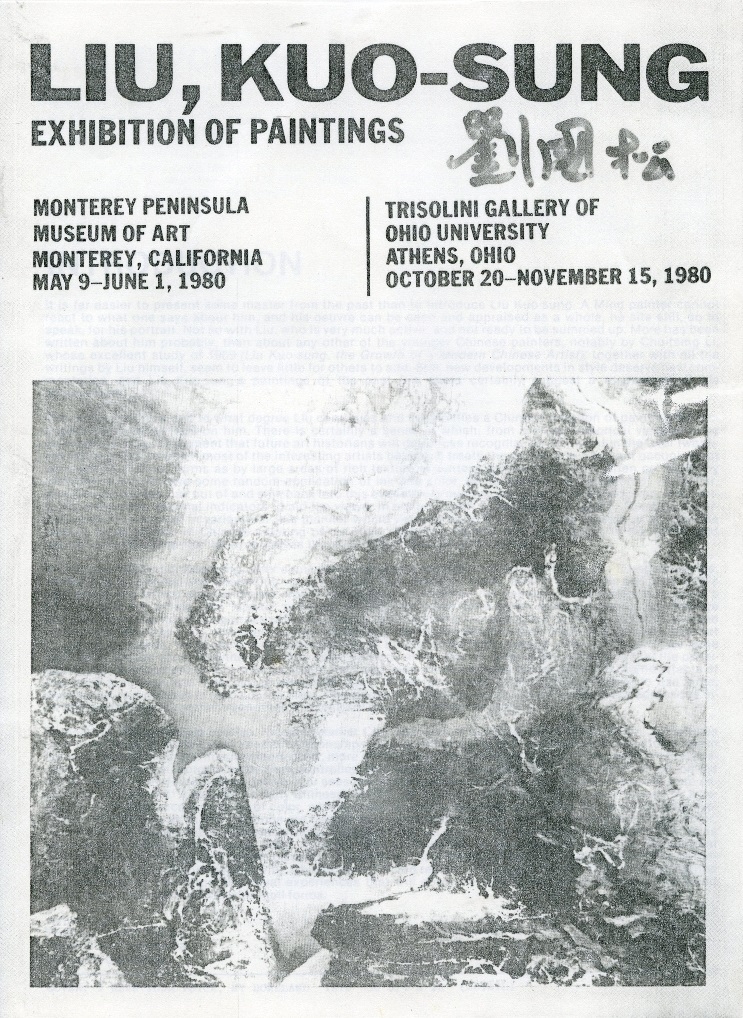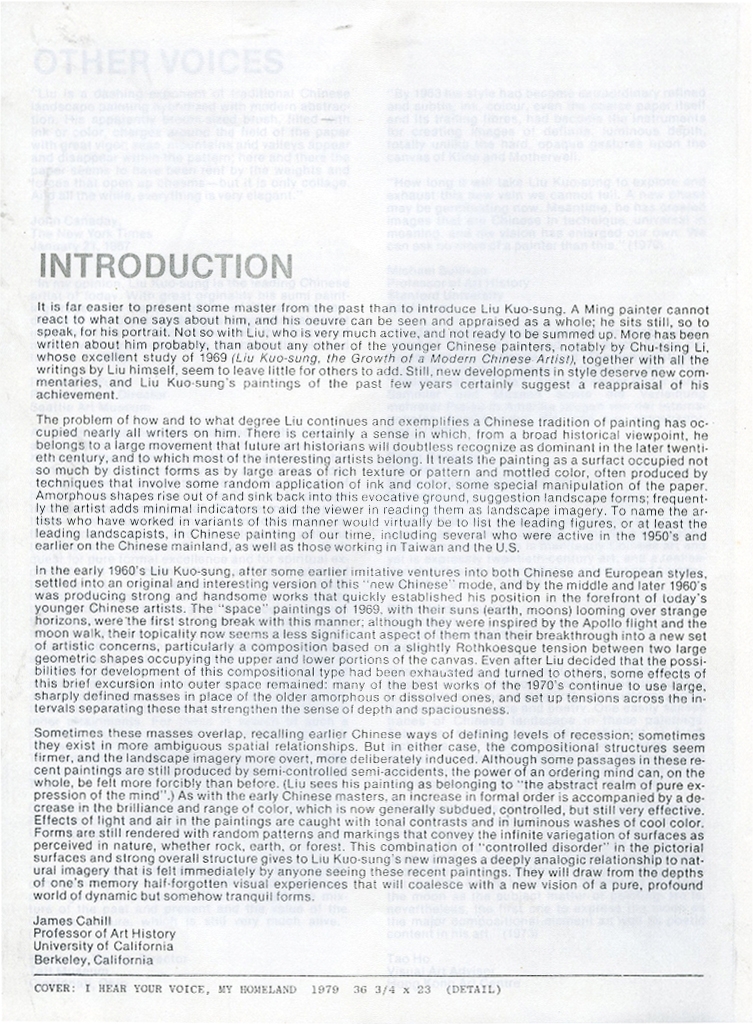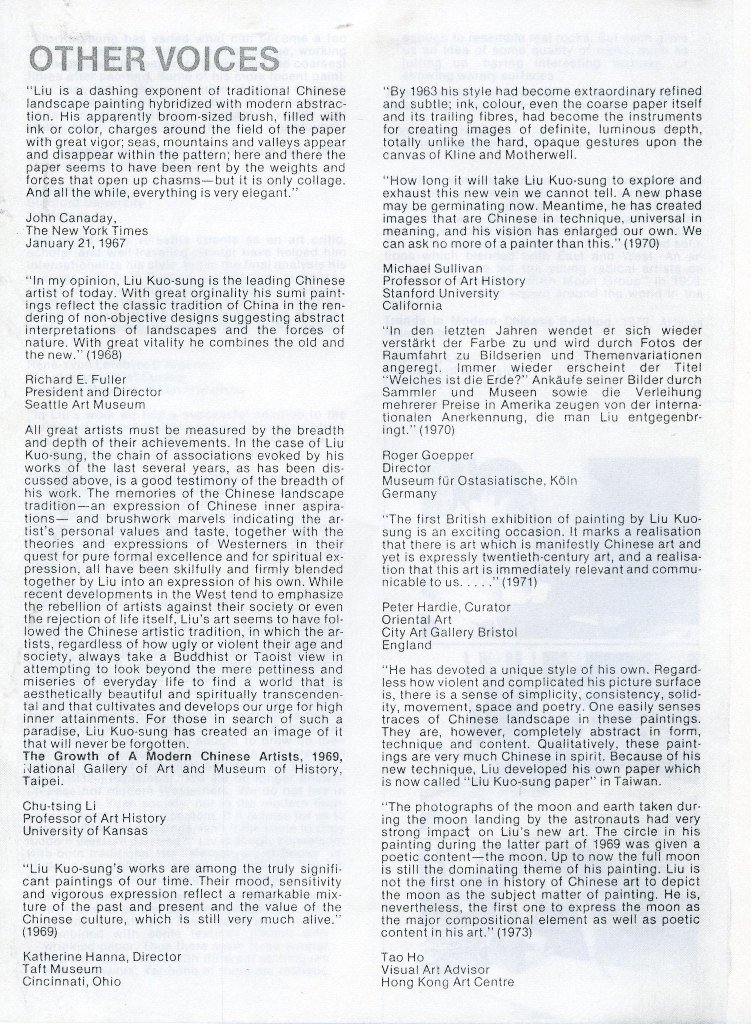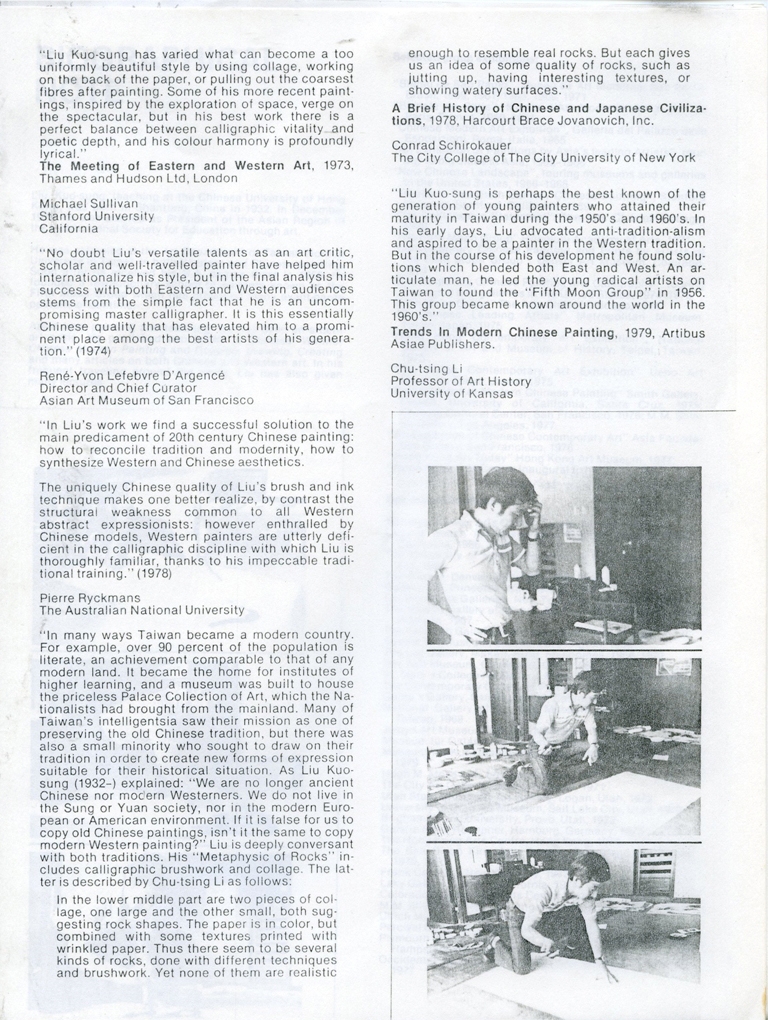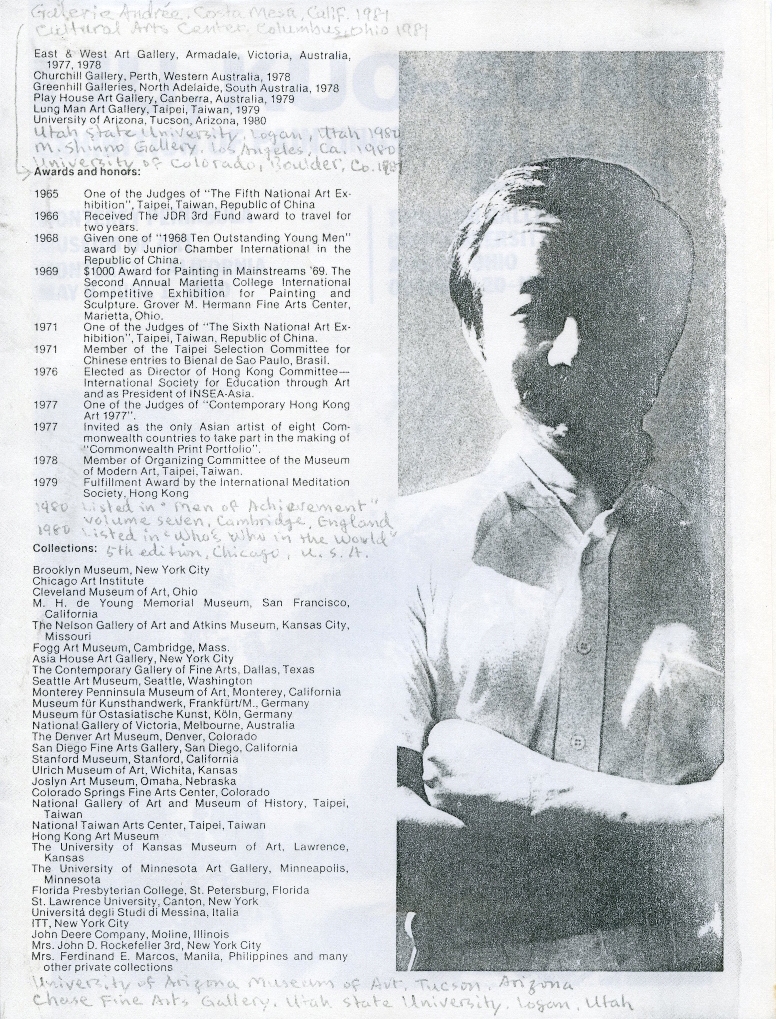LIU, KUO-SUNG EXHIBITION OF PAINTINGS
- Literature
- James Cahill
- 1980.5
INTRODUCTION
It is far easier to present some master from the past than to introduce Liu Kuo-sung. A Ming painter cannot react to what one says about him, and his oeuvre can be seen and appraised as a whole; he sits still, so to speak, for his portrait. Not so with Liu, who is very much active, and not ready to be summed up. More has been written about him probably, than about any other of the younger Chinese painters, notably by Chu-tsing Li, whose excellent study of 1969 (Liu Kuo-sung, the Growth of a Modern Chinese Artist), together with all the writings by Liu himself, seem to leave little for others to add. Still, new developments in style deserve new commentaries, and Liu Kuo-sung’s paintings of the past few years certainly suggest a reappraisal of his achievement.
The problem of how and to what degree Liu continues and exemplifies a Chinese tradition of painting has occupied nearly all writers on him. There is certainly a sense in which, from a broad historical viewpoint, he belongs to a large movement that future art historians will doubtless recognize as a dominant in the later twentieth century, and to which most of the interesting artists belong. It treats the painting as a surface occupied not so much by distinct forms as by large areas of rich texture or pattern and mottled color, often produced by techniques that involve some random application of ink and color, some special manipulation of the paper. Amorphous shapes rise out of and sink back into this evocative ground, suggestion landscape forms; frequently the artist adds minimal indicators to aid the viewer in reading them as landscape imagery. To name the artists who have worked in variants of this manner would virtually be to list the leading figures, or at least the leading landscapists, in Chinese painting of our time, including several who were active in the 1950’s and the earlier on the Chinese mainland, as well as those working in Taiwan and the U.S.
In the early 1960’s Liu Kuo-sung, after some earlier imitative ventures into both Chinese and European styles, settled into an original and interesting version of this “new Chinese” mode, and by the middle and later 1960’s was producing strong and handsome works that quickly established his position in the forefront of today’s younger Chinese artists. The “space” paintings of 1969, with their suns (earth, moons) looming over strange horizons, were the first strong break with this manner; although they were inspired by the Apollo flight and the moon walk, their topicality now seems a less significant aspect of them than their breakthrough into a new set of artistic concerns, particularly a composition based on a slightly Rothkoesque tension between two large geometric shapes occupying the upper and lower portions of the canvas. Even after Liu decided that the possibilities for development of this compositional type had been exhausted and turned to others, some effects of this brief excursion into outer space remained: many of the best works of the 1970’s continue to use large, sharply defined masses in place of the older amorphous or dissolved ones, and set up tensions across the intervals separating these that strengthen the sense of depth and spaciousness.
Sometimes these masses overlap, recalling earlier Chinese ways of defining levels of recession; sometimes they exist in more ambiguous spatial relationships. But in either case, the compositional structures seem firmer, and the landscape imagery more overt, more deliberately induced. Although some passages in these recent paintings are still produced by semi-controlled semi-accidents, the power of an ordering mind can, on the whole, be felt more forcibly than before. (Liu sees his painting as belonging to “the abstract realm of pure expression of the mind”.) As with the early Chinese masters, an increase in formal order is accompanied by a decrease in the brilliance and range of color, which is now generally subdued, controlled, but still very effective. Effects of light and air in the paintings are caught with tonal contrasts and in luminous washes of cool color. Forms are still rendered with random patterns and markings that convey the infinite variegation of surfaces as perceived in nature, whether rock, earth, or forest. This combination of “controlled disorder” in the pictorial surfaces and strong overall structure gives to Liu Kuo-sung’s new images a deeply analogic relationship to natural imagery that is felt immediately by anyone seeing these recent paintings. They will draw from the depths of one’s memory half-forgotten visual experiences that will coalesce within a new vision of a pure, profound world of dynamic but somehow tranquil forms.
James Cahill
Professor of Art History
University of California
Berkeley, California
────────
Other Voices
“Liu is a dashing exponent of traditional Chinese landscape painting hybridized with modern abstraction. His apparently broom-sized brush, filled with ink or color, charges around the field of the paper with great vigor; seas, mountains and valleys appear and disappear within the pattern; here and there the paper seems to have been rent by the weights and forces that open up chasms – but it is only collage. And all the while, everything is very elegant.”
John Canaday,
The New York Times
January 21, 1967
--------------------
“In my opinion, Liu Kuo-sung is the leading Chinese artist of today. With great originality his sumi paintings reflect the classic tradition of China in the render of non-objective designs suggesting abstract interpretations of landscapes and the forces of nature. With great vitality he combines the old and the new.” (1968)
Richard E. Fuller
President and Director
Seattle Art Museum
--------------------
All great artists must be measured by the breadth and depth of their achievements. In the case of Liu Kuo-sung, the chain of associations evoked by his works of the last several years, as has been discussed above, is a good testimony of the breadth of his work. The memories of the Chinese landscape tradition – an expression of Chinese inner aspirations – and brushwork marvels indicating the artist’s personal values and taste, together with the theories and expressions of Westerners in their quest for pure formal excellence and for spiritual expression, all have been skilfully and firmly blended together by Liu into an expression of his own. While recent developments in the West tend to emphasize the rebellion of artists against their society or even the rejection of life itself, Liu’s art seems to have followed the Chinese artistic tradition, in which the artists, regardless of how ugly or violent their age and society, always take a Buddhist or Taoist view in attempting to look beyond the mere pettiness and miseries of everyday life to find a world that is aesthetically beautiful and spiritually transcendental and that cultivates and develops our urge for high inner attainments. For those in search of such a paradise, Liu Kuo-sung has created an image of it that will never be forgotten.
The Growth of A Modern Chinese Artists, 1969,
National Gallery of Art and Museum of History, Taipei.
Chu-tsing Li
Professor of Art History
University of Kansas
--------------------
“Liu Kuo-sung’s works are among the truly significant paintings of our time. Their mood, sensitivity and vigorous expression reflect a remarkable mixture of the past and present and the value of the Chinese culture, which is still very much alive.” (1969)
Katherine Hanna, Director
Taft Museum
Cincinnati, Ohio
--------------------
“By 1963 his style had become extraordinary refined and subtle; ink, colour, even the coarse paper itself and its trailing fibres, had become the instruments for creating images of definite, luminous depth, totally unlike the hard, opaque gestures upon the canvas of Kline and Motherwell.
“How long it will take Liu Kuo-sung to explore and exhaust this new vein we cannot tell. A new phase may be germinating now. Meantime, he has created images that are Chinese in technique, universal in meaning, and his vison has enlarged our own. We can ask no more of a painter than this.” (1970)
Michael Sullivan
Professor of Art History
Stanford University
California
--------------------
“The first British exhibition of painting by Liu Kuo-sung is an exciting occasion. It marks a realisation that there is art which is manifestly Chinese art and yet is expressly twentieth-century art, and a realisation that art is immediately relevant and communicable to us….” (1971)
Peter Hardie, Curator
Oriental Art
City Art Gallery Bristol
England
--------------------
“He has devoted a unique style of his own. Regardless how violent and complicated his picture surface is, there is a sense of simplicity, consistency, solidity, movement, space and poetry. One easily senses traces of Chinese landscape in these paintings. They are, however, completely abstract in form, technique and content. Qualitatively, these paintings are very much Chinese in spirit. Because of his new technique, Liu developed his own paper which is now called “Liu Kuo-sung paper” in Taiwan.
“The photographs of the moon and earth taken during the moon landing by the astronauts had very strong impact on Liu’s new art. The circle in his painting during the latter part of 1969 was given poetic content – the moon. Up to now the full moon is still the dominating theme of his painting. Liu is not the first one in history of Chinese art to depict the moon as the subject matter of painting. He is, nevertheless, the first one to express the moon as the major compositional element as well as poetic content in his art.” (1973)
Tao Ho
Visual Art Advisor
Hong Kong Art Centre
--------------------
“Liu Kuo-sung has varied what can become a too uniformly beautiful style by using collage, working on the back of the paper, or pulling out the coarsest fibres after painting. Some of his more recent paintings, inspired by the exploration of space, verge on the spectacular, but in his best work there is a perfect balance between calligraphic vitality and poetic depth, and his colour harmony is profoundly lyrical.”
The Meeting of Eastern and Western Art, 1973, Thames and Hudson Ltd, London
Michael Sullivan
Stanford University
California
--------------------
“No doubt Liu’s versatile talents as an art critic, scholar and well-travelled painter have helped him internationalize his style, but in the final analysis his success with both Eastern and Western audiences stems from the simple fact that he is an uncompromising master calligrapher. It is this essentially Chinese quality that has elevated him to a prominent place among the best artist of his generation.” (1974)
Rene-Yvon Lefebvre d’Argence
Director and Chief Curator
Asian Art Museum of San Francisco
--------------------
The problem of how and to what degree Liu continues and exemplifies a Chinese tradition of painting has occupied nearly all writers on him. There is certainly a sense in which, from a broad historical viewpoint, he belongs to a large movement that future art historians will doubtless recognize as dominant in the later twentieth century, and to which most of the interesting artists belong. It treats the painting as a surface occupied not so much by distinct forms as by large areas of rich texture or pattern and mottled color, often produced by techniques that involve some random application of ink and color, some special manipulation of the paper. (1977)
James Cahill
Professor of Art History
University of California
Berkeley
--------------------
“In Liu’s work we find a successful solution to the main predicament of 20th century Chinese painting: how to reconcile tradition and modernity, how to synthesize Western and Chinese aesthetics.
The uniquely Chinese quality of Liu’s brush and ink technique makes one better realize, by contrast to the structural weakness common to all Western abstract expressionists: however enthralled by Chinese models, Western painters are utterly deficient in the calligraphic discipline with which Liu is thoroughly familiar, thanks to his impeccable traditional training.” (1978)
Pierre Ryckmans
The Australian National University
--------------------
“In many ways Taiwan became a modern country. For example, over 90 percent of the population is literate, an achievement comparable to that of any modern land. It became the home for institutes of higher learning, and a museum was built to house the priceless Palace Collection of Art, which the Nationalists had brought from the mainland. Many of Taiwan’s intelligentsia saw their mission as one of preserving the old Chinese tradition, but there was also a small minority who sought to draw on their tradition in order to create new forms of expression suitable for their historical situation. As Liu Kuo-sung (1932-) explained: “We are no longer ancient Chinese nor modern Westerners. We do not live in the Sung or Yuan society, nor in the modern European or American environment. If it is false for us to copy old Chinese paintings, isn’t it the same to copy modern Western painting?” Liu is deeply conversant with both traditions. His “Metaphysic of Rocks” includes calligraphic brushwork and collage. The latter is described by Chu-tsing Li as follows:
In the lower middle part are two pieces of collage, one large and the other small, both suggesting rock shapes. The paper is in color, but combined with some textures printed with wrinkled paper. Thus there seem to be several kinds of rocks, done with different techniques and brushwork. Yet none of them are realistic enough to resemble real rocks. But each gives us an idea of some quality of rocks, such as jutting up, having interesting textures, or showing watery surfaces.”
A Brief History of Chinese and Japanese Civilizations, 1978, Harcourt Brace Jovanovich, Inc.
Conrad Schirokauer
The City College of The City University of New York
--------------------
“Liu Kuo-sung is perhaps the best known of the generation of young painters who attained their maturity in Taiwan during the 1950’s and 1960’s. In his early days, Liu advocated anti-traditionalism and aspired to be a painter in the Western tradition. But in the course of his development he found solutions which blend both East and West. An articulate man, he led the young radical artists on Taiwan to found the “Fifth Moon Group” in 1956. This group became known around the world in the 1960’s.”
Trends In Modern Chinese Painting, 1979, Artibus Asiae Publishers.
Chu-tsing Li
Professor of Art History
University of Kansas
────────────
Biographical Note
Liu Kuo-sung, teaching at the Chinese University of Hong Kong, was born in Shantung, China in 1932. In December 1976, he was elected as President of the Asian Region of the International Society for Education through art.
He was schooled at the Art Department of Taiwan Normal University in Taipei in both Western and Chinese painting. Soon after he received his B.A. degree there in 1956, he founded a revolutionary school of painters known as the Fifth Moon Group which has produced many avant-garde painters of our time.
Apart from painting and teaching, Liu has been an ardent art critic. He published two books in Chinese: Whither Chinese Modern Painting and Copying, Drawing, Creating and many articles on both Chinese and Western art. In his frequent traveling around the world, Liu has also given many lectures.
Selected group exhibitions:
“Bienal de Sao Paulo”, Museo de Art Moderna, Sao Paulo, Brazil, 1959, 1961, 1963, 1969, 1971
“Bienale de Paris”, Musée d’Art Moderne de la Ville de Paris, France, 1959, 1961
“Chinese Modern Art Exhibition”, Galleria del Palazzo delle Esposizioni, Roma, Italia, 1965
“An Exhibition of Paintings by Asia’s leading Artists”, touring 10 big cities in Asia, 1965-1966
“New Chinese Landscape”, touring museums and galleries in the United States, 1966-1968
“Trends in Twentieth Century Chinese Painting”, Stanford Museum, Stanford, California, 1969
“The Calligraphic Statement”, The Arts Club of Chicago, 1970
“The Fifth Moon Group”, Honolulu Academy of Arts, 1971
“Contemporary Chinese Painting and Prints by Artists of the Fifth Moon Group”, Denver Art Museum, Colorado, 1973
“Contemporary Chinese Painting and Calligraphy”, touring museums and galleries in the United States, 1974-1975
“Fifth Moon Group”, The Arts Club of Chicago, 1974
“10 Chinese Leading Artists”, Metropolitan Museum, Tokyo, Japan, 1975
“Hong Kong Contemporary Art Exhibition”, National Gallery of Art and Museum of History, Taipei, Taiwan, 1975
“11th Asian Contemporary Art Exhibition”, Ueno Art Museum, Tokyo, Japan, 1975
“Frontrunners in Modern Chinese Painting” Smith Gallery, Cowell, University of California, Santa Cruz, 1975; Chinese Cultural Center, San Francisco, 1976; M.M. Shinno Gallery, Los Angeles, 1977
“An Exhibition of Chinese Contemporary Art”, Asia Foundation Gallery, San Francisco, 1976
“Hong Kong Art Today” Hong Kong Art Museum, 1977
“Hong Kong Arts Centre Inaugural Exhibition”, 1977
“Artist 79”, United Nations, New York City, 1979
One-man exhibitions:
National Taiwan Arts Center, Taipei, Taiwan, 1965
Laguna Beach Art Association Gallery, Laguna Beach, California, 1966, 1970
The University of Kansas Museum of Art, Lawrence, Kansas, 1966
The Gallery, Denver, Colorado, 1966, 1968
Gallery 100, Princeton, New Jersey, 1967
Lee Nordness Galleries, New York City, 1967, 1969, 1970
The Nelson Gallery of Art and Atkins Museum, Kansas City, Missouri, 1967
The Coffman Gallery, University of Minnesota, 1967
Seattle Art Museum, Seattle, Washington, 1968
The Luz Gallery, Makati, Rizal, Philippines, 1968, 1972
The Taft Museum, Cincinnati, Ohio, 1968-1969
St. Mary’s College Art Gallery, Notre Dame, Indiana, 1969
The Contemporary Gallery of Fine Arts, Dallas, Texas, 1969
Gump‘s Gallery, San Francisco, California, 1969
National Gallery of Art and Museum of History, Taipei, Taiwan, 1969
Joslyn Art Museum, Omaha, Nebraska, 1970
Museum für Ostasiatische Kunst, Köln, Germany, 1970-71
Museum für Kunsthandwerk, Frankfurt/M., Germany, 1971, 1979
Hugh M. Moss Ltd., London, England 1971
The City Art Gallery, Bristol, England, 1971
Utah State University Art Gallery, Logan, Utah, 1972
University of Utah Art Museum, Salt Lake City, Utah, 1972
Brigham Young University, Provo, Utah, 1972
Galerie Hans Hoeppner, Hamburg, Germany, 1972
The Hong Kong Arts Centre, Hong Kong, 1973
The San Diego Fine Arts Gallery, San Diego, California, 1970, 1973
Frank Caro Co., New York City, 1973
Laky Gallery, Carmel, California, 1974, 1977
Colorado Springs Fine Arts Center, Colorado, 1975
M.M. Shinno Gallery, Los Angeles, California, 1975, 1979, 1980
Ulrich Museum of Art, Wichita, Kansas, 1976-1980
Percival Galleries, Des Moines, Iowa, 1976
Plymouth State College Art Gallery, University of New Hampshire, Plymouth, New Hampshire, 1977
Occidental College of Art Gallery, Los Angeles, California, 1977
East & West Art Gallery, Armadale, Victoria, Australia, 1977, 1978
Churchill Gallery, Perth, Western Australia, 1978
Greenhill Galleries, North Adelaide, South Australia, 1978
Play House Art Gallery, Canberra, Australia, 1979
Lung Man Art Gallery, Taipei, Taiwan, 1979
University of Arizona, Tucson, Arizona, 1980
Utah State University, Logan, Utah, 1980
University of Colorado, Boulder, Colorado, 1981
Galerie Andrée, Costa Mesa, California, 1981
Cultural Arts Center, Columbus, Ohio, 1981
Awards and honors:
|
1965 |
One of the Judges of “The Fifth National Art Exhibition”, Taipei, Taiwan, Republic of China |
|
1966 |
Received The JDR 3rdFund award to travel for two years |
|
1968 |
Given one of “1968 Ten Outstanding Young Men” award by Junior Chamber International in the Republic of China. |
|
1969 |
$1000 Award for Painting in Mainstreams ’69. The Second Annual Marietta College International Competitive Exhibition for Painting and Sculpture Grover M. Hermann Fine Arts Center, Marietta, Ohio |
|
1971 |
One of the Judges of “The Sixth National Art Exhibition”, Taipei, Taiwan, Republic of China |
|
1971 |
Member of the Taipei Selection Committee for Chinese entries to Bienal de Sao Paulo, Brazil |
|
1976 |
Elected as Director of Hong Kong Committee – International Society for Education through Art and as President of INSEA-Asia |
|
1977 |
One of the Judges of “Contemporary Hong Kong Art 1977” |
|
1977 |
Invited as the only Asian artist of eight Commonwealth countries to take part in making of “Commonwealth Print Portfolio” |
|
1978 |
Member of Organizing Committee of the Museum of Modern Art, Taipei, Taiwan |
|
1979 |
Fulfillment Award by the International Meditation Society, Hong Kong |
|
1980 |
Listed in “Men of Achievement” Volume 7, Cambridge, England |
|
1980 |
Listed in “Who’s Who in the World”, 5thEdition, Chicago, U.S.A. |
Collections:
Brooklyn Museum, New York City
Chicago Art Institute
Cleveland Museum of Art, Ohio
M. H. de Young Memorial Museum, San Francisco, California
The Nelson Gallery of Art and Atkins Museum, Kansas City, Missouri
Fogg Art Museum, Cambridge, Massachusetts
Asia House Art Gallery, New York City
The Contemporary Gallery of Fine Arts, Dallas, Texas
Seattle Art Museum, Seattle, Washington
Monterey Peninsula Museum of Art, Monterey, California
Museum für Kunsthandwerk Kunst, Frankfurt/M., Germany
Museum für Ostasiatische, Köln, Germany
National Gallery of Victoria, Melbourne, Australia
The Denver Art Museum, Denver, Colorado
San Diego Fine Arts Gallery, San Diego, California
Stanford Museum, Stanford, California
Ulrich Museum of Art, Wichita, Kansas
Joslyn Art Museum, Omaha, Nebraska
Colorado Springs Fine Arts Center, Colorado
National Gallery of Art and Museum of History, Taipei, Taiwan
National Taiwan Arts Center, Taipei, Taiwan
Hong Kong Art Museum
The University of Kansas Museum of Art, Lawrence, Kansas
The University of Minnesota Art Gallery, Minneapolis, Minnesota
Florida Presbyterian College, St. Petersburg, Florida
St. Lawrence University, Canton, New York
Universitá degli Studi di Messina, Italia
ITT, New York City
John Deere Company, Moline, Illinois
Mrs. John D. Rockefeller 3rd, New York City
Mrs. Ferdinand E. Marcos, Manila Philippines
University of Arizona Museum of Art, Tucson, Arizona
Chase Fine Arts Gallery, Utah State University, Logan, Utah
